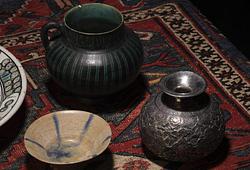Anna Petrus
An engraved Swedish Grace pewter tray, Stockholm, early 1920's. this model was shown at The Paris Exhibition 1925.
Executed in her own workshop, Stockholm, Adam & Eve in the garden of Eden, signed A. Petrus, 45 x 23,5 cm.
Later wall mount.
Provenance
The Kuylenstierna family. The tray was acquired directly from Anna Petrus, thence by descent.
Exhibitions
This model was included in the Swedish Pavillion at the 1925 Paris World's Fair and was also depicted on a full page in the Swedish Exhibition catalogue.
Literature
Marie Rehnberg, "Anna Petrus Skulptör och Industrikonstnär", Bokförlaget Signum 2009, the model illustrated p 79.
More information
ANNA PETRUS (1886-1949)
Anna Petrus is described as an independent and strong personality, she was a modern woman driven by passion for her work.
In her studio on Riddargatan in Stockholm, Anna Petrus began to take an interest in crafts in the early 1920s. She came to make several different types of trays of different materials; tin, copper and sometimes with elements of silver. The trays were provided with a richly engraved décor and were sometimes combined with artfully sculpted lions of oak.
Designer
Anna Petrus was a sculptor, industrial designer, and artist active in the early 20th century. She was born as Anna Petersson, the daughter of a professor of medicine and a countess, and adopted her surname while studying at the Royal Academy of Fine Arts. She inherited a modest fortune at the age of 11 when her mother passed away, which allowed her to pursue her education in London and travel to Italy and France.
Anna Petrus's major international breakthrough came with the Exposition Internationale des Arts Décoratifs et Industriels Modernes in Paris in 1925, where she showcased items in pewter and cast iron, in the Swedish Grace style. Pewter was considered an outdated material at the time, but its popularity grew as designers like Petrus recognised its advantages. In 1924, she began a collaboration with the then newly established Firma Svenskt Tenn. The lion became a recurring motif in Anna Petrus's work, both as sculptures and as stylised decorations.
Read more






































